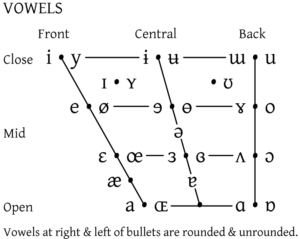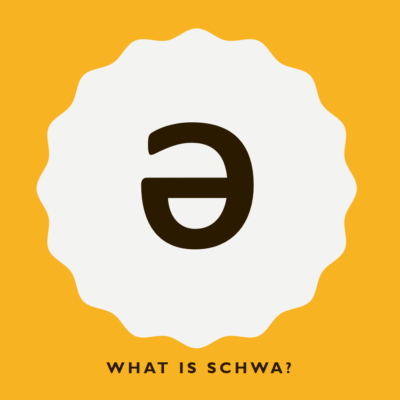A friend asked me this question recently. I thought the answer was simple, something along the lines of ‘it is the sound you make in unstressed syllables when your oral articulators are doing nothing and your vocal folds vibrate’. A sort of unmarked setting of the articulatory muscles if you will. But alas, nothing is ever as simple as it seems which I quickly realised during my reading. And what better way to share my new insights than with a Lingoblog entry! The focus of this blog post is the articulatory aspects of schwa, though many other interesting fields are relevant to a description of the sound.
Is schwa a mid-central vowel?
Schwa (named after a Hebrew diacritic by German philologists) is the initial ‘weak’ sound in words like apart and except and is traditionally thought of as a mid-central vowel, transcribed [ə] in the International Phonetic Alphabet, indicating that vowel reduction to schwa involves an approximation of the vowel space centre:

Variability of non-final schwa
Two factors are involved in the strong variability of the sound: non-final schwa is both very short and does not minimally contrast with other vowel qualities (Flemming 2004). According to Lindblom (1963) there is an ‘undershooting’ of the target taking place (the target being full vowels) as vowel duration decreases. Further, short and unstressed syllables are subject to neutralisation, i.e. schwa, as they are an ineffective place for vowel contrasts (which distinguish meaning) because these need to be perceptually distinct to the listener (Liljencrants and Lindblom 1972; Flemming 2004). Undershooting a full vowel target in an articulatory very quick fashion makes the auditory result very much not distinct.
So we know now that non-final schwa is highly varied and context-driven. The question is then, at least if you are a phonetician and into articulatory dynamics, do speakers aim at a particular setting of the vocal tract when producing schwa? Or in other words, if the variability is so large, does it make sense to say that schwa has an articulatory target?
Does schwa have a target?
Bates (1995: 266-267) has suggested that schwa is ‘inherently unspecified for tongue position’. This statement is modified by Browman and Goldstein (1992) who argue that schwa theoretically does have a lingual, i.e. tongue, target but that this can be completely overwritten by the tongue gestures of the nearby sounds so that schwa in a word like later becomes more like the first portion of the vowel in the first syllable (an open-mid front vowel rather than a mid-central vowel). In practical terms, then, schwa appears to be targetless. However, as we have seen, this is also dependent on the position of schwa as it word-finally is more resistant to coarticulation (but not fully resistant as the example of later shows) and further, the Browman and Goldstein (1992) study did not clearly specify the position of schwa when investigating the articulatory gestures involved in its production. As pointed out by Flemming (2009) it can also be argued that even if schwa is targetless for place of articulatory gestures, it still has a manner specification in being a vowel, not a consonant, and vowels have to be realised with an open, unobstructed vocal tract. Flemming (2009) also found that non-final schwa was more varied in the anterior, i.e. front, part of the vocal tract (corresponding to an acoustic measurement linguists call the frequency of the second formant) than in the posterior, i.e. back, part (the frequency of the first formant). Based on this, he suggests that it may have a target for tongue height (vertical movement in the vocal tract) but less so for tongue backness (horizontal movement in the vocal tract). However, the variation observed in the anterior part of the vocal tract could merely indicate a strong deviation from a target rather than being proof of no target at all. In conclusion: it’s complicated but perhaps the articulatory target is theoretical at worst, or limited to tongue height at best.
Do all languages have schwa?
Having established its less than straightforward articulatory dynamics, let’s look at the universality of schwa. Languages like English and Danish have a lot of schwa going on, and in Danish schwa is often deleted so that the preceding sound becomes syllabic, i.e. the center of the syllable. This happens in a word like bade ‘bathe’ where the final vowel can be dropped and the consonant constitutes the final syllable (e.g. Schachtenhaufen 2010). But not all languages have schwa; according to the database of phonological inventories Phoible (Moran and McCloy 2019), only 22% of languages have schwa in their inventory (the database only has data on about half of the world’s languages, however). In other languages schwa behaves differently and is not reduced but rather occurs as a full vowel in some circumstances and is even allowed to receive stress – many Balkan languages and dialects allow stressed schwa (Brown and Ogilvie 2008).
As this blog post has shown, schwa is more complex than being a ‘neutral vowel’ in the middle of the vowel space. It is a dynamic and variable sound and much research remains to be conducted about it, particularly investigating non-English schwa.
Andrea Brink Siem has an MA in Linguistics from Aarhus University and is currently doing a Ph.D. in articulatory phonetics at Lancaster University.
References:
Bates, Sally. 1995. Towards a definition of schwa: an acoustic investigation of vowel reduction in English. Ph.D. dissertation, University of Edinburgh.
Browman Catherine P. & Louis Goldstein. 1990. Gestural specification using dynamically-defined articulatory structures. Journal of Phonetics 18: 299–320.
Browman, Catherine P. & Louis Goldstein. 1992. “Targetless” schwa: an articulatory analysis. Papers in laboratory phonology II: Gesture, segment, prosody: 26–56.
Brown, Keith & Sarah Ogilvie. 2008. Concise Encyclopedia of Languages of the World. Amsterdam: Elsevier Science Publishing Company
Flemming, Edward. 2004. Contrast and perceptual distinctiveness. Hayes, B., Kirchner, R. & Steriade, D. (eds.) Phonetically-Based Phonology: 232—276. Cambridge: Cambridge University Press.
Flemming, Edward & Stephanie Johnson. 2007. Rosa’s roses: reduced vowels in American English. Journal of the International Phonetic Association 37: 83-96.
Flemming, Edward. 2009. The phonetics of schwa vowels. Donka Minova (ed.) Phonological Weakness in English. Palgrave (pre-publication version).
Kondo, Yuko. 1994. Targetless schwa: is that how we get the impression of stress timing in English? Proceedings of the Edinburgh Linguistics Department Conference ’94: 63-76.
Liljencrants, Johan & Björn Lindblom. 1972. Numerical simulation of vowel quality systems: The role of perceptual contrast. Language 48: 839-862.
Lindblom, Björn. 1963. Spectrographic study of vowel reduction. Journal of the Acoustical Society of America 35: 1773-1781.
Moran, Steven & Daniel McCloy (eds.) 2019. PHOIBLE 2.0. Jena: Max Planck Institute for the Science of Human History. (Available online at http://phoible.org, Accessed on 2020-05-01.)
Olive, Joseph P., Alice Greenwood & John Coleman. 1993. Acoustics of American English speech: A dynamic approach. New York: Springer Science & Business Media.
Schachtenhaufen, Ruben. 2010. Looking for lost syllables in Danish spontaneous speech. In Peter
Juel Henrichsen (ed.) Linguistic Theory and Raw Sound. Copenhagen: Samfundslitteratur.






